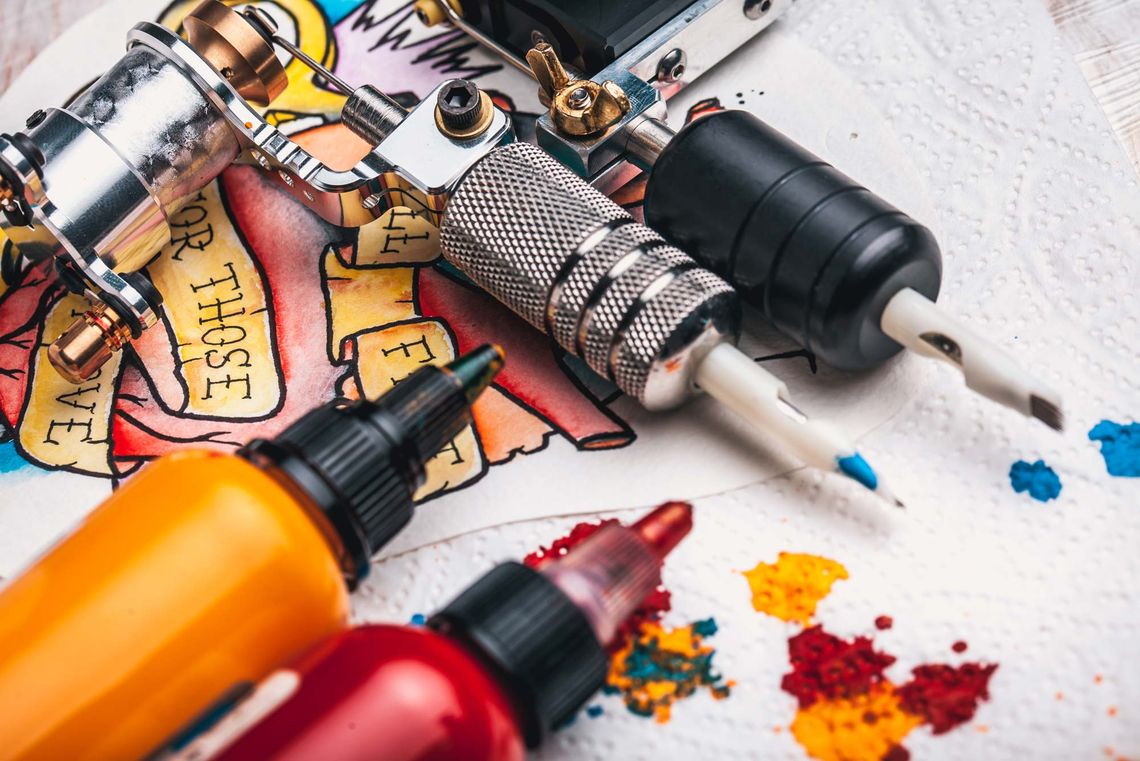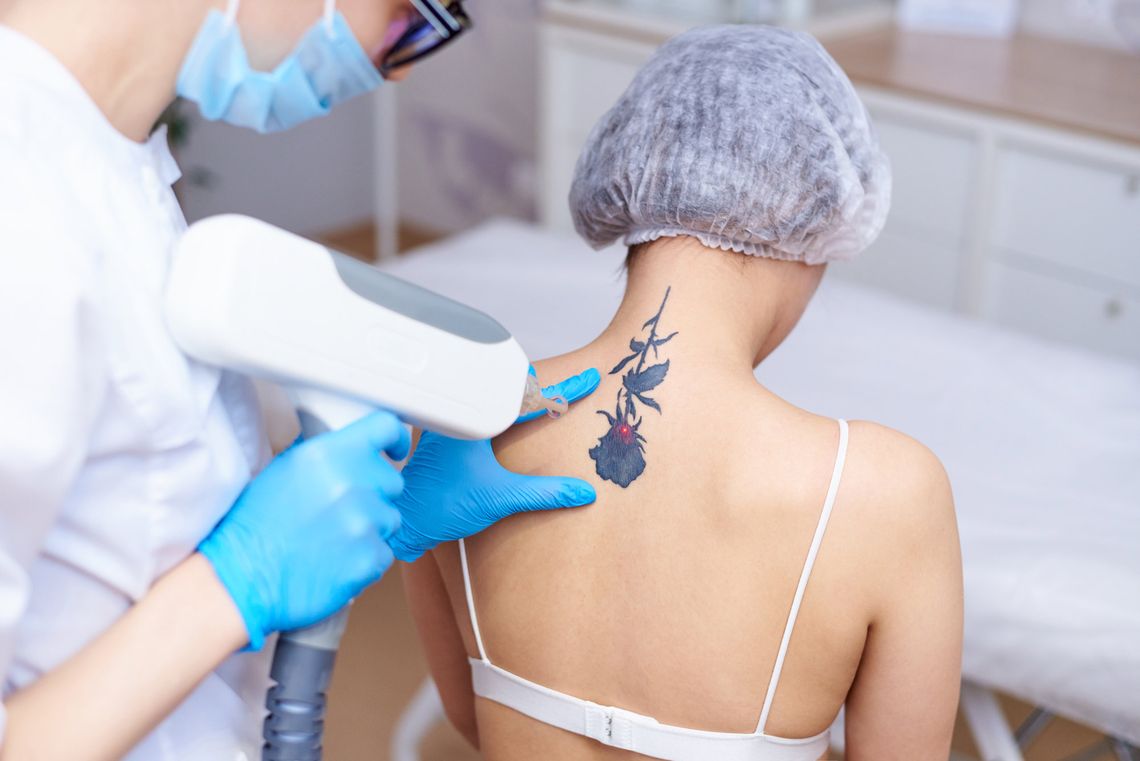According to recent surveys, 17% of the population in Germany have a tattoo. Of these, about 20% regret this fact. We take this statistic as an opportunity to take a closer look at the topic, so we went a couple of doors down the mall and interviewed our neighbour Andy! Andy is our local tattoo artist with whom we collaborated on several tattoo studies.
- Kategorie
- Datum
- Teilen
Hi Andy! How long have you been a tattoo artist?
About 25 years. I started out commuting between Frankfurt and Nice, where I was able to work in two studios. Then I slowly built up my own studio in France and worked there for ten years before coming here to Schenefeld.
So you've been in the business for quite some time!
You could say that...

At proderm we are very interested skin, skin health and the safety of products that come into contact with skin. In this regard, there is much to consider when it comes to tattooing, right?
Tattooing really has a lot to do with health, hygiene and skin care! If I had known that, I probably wouldn't have started tattooing in the first place! In France, the standards are different than in Germany, so I first had to do a hygiene course to officially document that my hygiene standards where sufficient, even though I was already working on that level. Hygiene and cleanliness in the tattoo studio are extremely important!
And when you think about the equipment? Is there much that can go wrong? Is it important to use the right equipment?
Well, there are tattoo machines and parts that you can order on the Internet. If somebody says on a whim: "I'm going to become a tattoo artist", there are actually kits that go for a 100 € or so. That's ridiculous. These machines are not even adjustable and are constantly changing speed. When you try to tattoo a line, sometimes you'll get a solid line, sometimes a very faint line.
So it's very important to have good material, and a lot has changed. The ink, for example: Since January, there are new regulations for tattoo ink imposed by the EU.
Because tattoo inks now fall under the EU Reach Regulation?
Yes, exactly, Reach-compliant inks. It was made mandatory to use them. We had the problem of not knowing which manufacturer produces good ink! Of course, I completely fell flat on my face the first time I ordered from one of the manufacturers and they really only sent me inferior ink - that was 150€ for the trash can, right?
So now it's kind of a phase where you're trying out which inks are good?
That's more or less behind us now; there are already manufacturers that I know make good Reach-compliant ink.
However, they can't deliver all the colors at the moment and you can really only order as you go which is really difficult at the moment.

How is the color intensity actually determined? By the speed of the tattoo machine?
The intensity is determined more by the force of the machine in conjunction with the type of needle. You can set it to hit a little harder or very lightly to make a very fine line or a stronger line.
And is it also possible to influence the depth of the color in any way?
So the depth is mainly a matter of feeling. I can teach someone how to tattoo, but always hitting the same depth is a matter of practice.
What difference does it make how deep you go?
Beginners, for example, often complain that their lines look very weird. A typical beginner's mistake in this regard is to tattoo areas with very thin skin for example. And that's what we call in our tattoo language "blow out", meaning that because you've gone too deep, the color seeps into the subcutaneous layer and then appears outside the lines, making them look blurry.
Does the tattoo disappear after some time if you apply the ink very superficially?
No, this is a misconception! Many, many years ago it was claimed that you can make so-called bio-tattoos which supposedly disappear within a year. The claim was that you could prick the skin so superficially that the ink would only stays in the epidermis. If you study the skin with its different layers, you know that there is a layer on top, the epidermis, which regenerates itself and underneath there is a layer where foreign bodies, like dirt and tattoo ink are permanently encapsulated. But in reality, the skin layers do not lie straight on top of each other but are kind of wavy. Even if the tattoo artist is very, very careful, the needle will always penetrate the epidermis and ink will end up in the dermis. The tattoo then fades quickly, but it does not disappear.
So, that means that some people were very surprised that they had to go for tattoo removal after all?
Yes. If one were to actually claim that a tattoo disappears, it would have to be gone within 4 to 8 weeks, because the epidermis regenerates completely in that time.
As we are brushing the topic of tattoo removal, you previously worked on a clinical study regarding that field, what exactly was that about?
Oh, yes the tattoo removal study!
We tested a liquid, that was introduced into the skin via a tattoo machine and that was supposed to remove the ink from the skin.

Did that work?
Yes, but a little too well so to speak, because the tattoo was gone, but so was any other pigmentation, because the skin was practically white afterwards, which is not something you necessarily strive for when removing a tattoo
And if people prefer their skin to look normal afterwards?
With today's technology, I believe you have to use a laser to get the best results in terms of skin appearance.
And lasers actually work?
Yes, but only at the dermatologist! In the past, practically anyone could perform laser tattoo removal, but unfortunately it must be said that while there are always people who want to prepare well and do a good job, there are also too many who just want to make money.
The German legislature has actually banned amateur laser removal since 2022 and now only dermatologists can offer that service. It is a huge difference from the laser studios we had before. Even if they had a laser for 20000€, it's still a toy compared to what they have at a real dermatology practice. - So I talked to my dermatologist recently and he said he got a new laser for 250000€ and that device can determine the depth and slope of the laser beams and remove different colors. With the low end devices you work by feel and you still have shadows in the skin afterwards…
Was that the only study you were involved with at proderm?
No, I also worked on studies in which we tested aftercare products for freshly inked tattoos. My job was to assess how they affected the quality of the tattoo. Fresh tattoos need good aftercare to prevent scaring and other issues.
Lack of aftercare can cause scarring?
Well, there are several ways. If someone who can't tattoo properly (a "scratcher" as we say in tattoo circles) violently digs around in the skin for too long, that leads to scarring, which leads to raised tattoo lines after the skin heals.
If you go and say "Oh, well the tattoo artist tells me to do this crazy aftercare routine, I'll do it once and then it'll be fine", crusts can form in some places where you had to apply a little more ink, and the tattoo will have irregularities if the crusts fall off.
What does tattoo aftercare look like?
Now there are an incredible lot of different care products that you can put on afterwards. Creams, plasters with gel, plasters with honey and so on.
They are sometimes quite expensive, which is why my recommendation is always to take a normal wound healing ointment, then you've actually already won.
There are very many creams on the market with additives, often products developed by tattoo artists. There may be substances such as tea tree oil or similar terpenes, which are supposed to have an antiseptic effect, but to which many people are allergic, which is of course counterproductive.
What do you think; will we cooperate on a tattoo study again in the future?
I sure hope so!
Contact
Would you like more information on the topic or would you like to get a quote? Please do not hesitate to contact our team.




